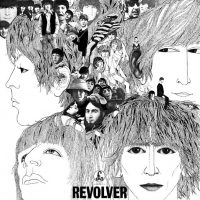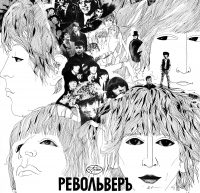The title
Revolver was named after the motion of a vinyl record as it was played, although there is an obvious double meaning which pleased the group.It’s just a name for an LP, and there’s no meaning to it. Why does everyone want a reason every time you move? It means Revolver. It’s all the things that Revolver means, because that’s what it means to us. Revolver and all the things we could think of to go with it.
The Beatles had some trouble settling on a name; their original title was Abracadabra, though this was later discarded.
Revolver did not mean a gun, but something that revolves, like a record. Johnny Dean, editor of Beatles Monthly, was with them on the night of 24 June 1966 in a Munich hotel room when they named the latter. At first they had all four wanted to call it Abracadabra, but someone had already used it. Pendulums and Fat Man and Bobby were other ideas. Ringo suggested having a joke with the Rolling Stones by calling it After Geography since the Stones had just done Aftermath! John proposed Beatles on Safari and Paul came up with Magic Circle. John changed this to Four Sides Of The Circle and Four Sides Of The Eternal Triangle, which somehow led them to Revolver.
Many Years From Now
Cover artwork
Revolver was the second Beatles album, after Rubber Soul, to not feature the group’s name on the front cover.
The black-and-white artwork was by Klaus Voormann, a musician and artist whom The Beatles befriended in Hamburg. It was made up partly of pen drawings, with collage sections including photographs by Robert Whitaker and Robert Freeman. Whitaker also took the photograph on the rear of the LP.
Klaus had been a great friend since Hamburg days – he’d been one of the ‘exis’, the existentialists whom we’d got to know then. We knew he drew and he’d been involved in graphic design; I must admit we didn’t really know what he did, but he’d been to college. We knew he must be all right and so we said, ‘Why don’t you come up with something for the album cover?’He did, and we were all very pleased with it. We liked the way there were little things coming out of people’s ears, and how he’d collaged things on a small scale while the drawings were on a big scale. He also knew us well enough to capture us rather beautifully in the drawings. We were flattered.
John Lennon telephoned Voormann, inviting him to work on The Beatles’ artwork. He visited the group in the studio, where they played him the Revolver recordings for inspiration.
Voormann chose black and white in an act of rebellion against the then-current fashion for brightly-coloured psychedelic covers. He worked from his studio at 29 Parliament Hill, London, where for two weeks he developed his concepts using pen and ink.
Voormann wanted The Beatles’ hair to be the focus, and drew likenesses of the group from memory. He then placed photos in and around the drawings.
John, Paul and I devoted an evening to sifting through an enormous pile of newspapers and magazines for pictures of The Beatles, after which we cut out the faces and glued them all together. Our handiwork was later superimposed onto a line drawing by Klaus Voormann, their old friend in Hamburg.
John Lennon: In My Life
The Beatles loved Voormann’s “scrapbook collage” artwork, and the group’s manager Brian Epstein was so overcome that he cried tears of joy. Voormann’s payment for the album cover was just £40. He did, however, win Grammy Award for Best Album Cover, Graphic Arts in 1967.
In Russia, Revolver was issued with a different collage and a recreation of Voorman’s drawing. This was an unofficial release by the St Petersburg label AnTrop.




Take off Yellow Submarine and replace it with Paperback Writer and then squeeze in Rain and this is the BEST Beatles album!!!
I disagree.I think it’s their most overrated album. Johns songs are scant and wierd without being particularly interesting.Abbey Road White Album Hard Days Night Help Meet the Beatles Rubber Soul Sgt Pepper and Magical Mystery Tour are all better even with those added songs
As to the “scantness” of John songs, are you referring to the US or UK version? The US version is three songs shorter, all John songs.
I think Revolver as an album in total is rather overrated. Yes, it displayed several revolutionally music studio technical ideas, and it is a very diverse collection of styles that somehow became new within pop music, but several of the songs were basically influenced from very traditional music, which naturally is alright, but not really that profound. It would probably pass unnoticed if the Beatles weren’t incredibly famous already.
There are some weak songs, such as Good Day Sunshine, and all in all it sounds like a compilation of three or four very different bands. Standing brilliantly out are I’m Only Sleeping, And Your Bird Can Sing, Here, There and Everywhere and Taxman. Also it’s a pity that several songs are faded out, just like on Rubber Soul. The idea with particularly composed endings and transitions between songs, like it is on Sgt Pepper, works so much better.
Personally, my second favorite album by The Beatles, one of the two albums in which I enjoy every single song, the only track that does not resonate with me is ‘Love You To’.
i do like this album, but yes, there are better beatles’ albums.